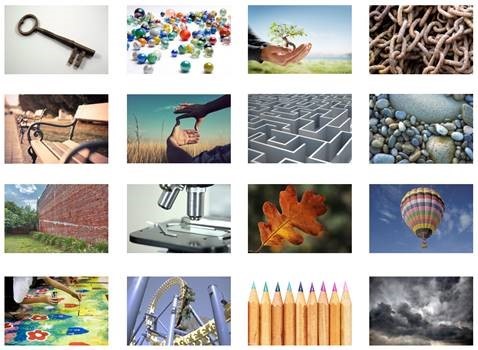Visual Metaphors Can Unlock Feelings That Are Imprisoned by Our Conscious Mind

Similes are like metaphors, and analogies are kissing cousins to both. These words point to a human tendency to think and communicate by making connections and comparisons. Metaphors are so common in our everyday language that we think about them as much as we think about breathing.
But metaphors and analogies go deeper than how we communicate—they permeate how we think. The theory of apperception suggests that we learn by making connections between new ideas and things we already know. And a tendency to think analogically may not be unique to humans—research indicates that chimpanzees can think metaphorically too.
Experiments suggest we make common connections between images and words or thoughts. First demonstrated by psychologist Wolfgang Köhler in 1929, Vilayanur S. Ramachandran and Edward M. Hubbard repeated Köhler's experiment in 2001. They asked American college undergraduates, and Tamil speakers in India, "Which of these shapes is bouba and which is kiki?"

In both groups, 95% to 98% selected the jagged shape as "kiki" and the curvy shape as "bouba."
Using visual metaphors to get past conscious thought
It is well understood that people are poor at articulating their thoughts and feelings. When we answer questions, we are often providing socially acceptable post-hoc rationalizations of unconscious thoughts and feelings, according to psychologists like Daniel Kahneman, and sociologists like Charles Tilly.
These rationalizations provide misleading information, so we avoid them like the plague. To get a better understanding of how people really think and feel, we turn to techniques that help us get past conscious thought. One of those techniques is metaphor elicitation.
In a recent study, we used metaphor elicitation to understand how people from our Innovation Forum Insight Community felt about artificial intelligence (AI). We presented people with the images below and asked them "which image best represents how you feel about artificial intelligence?"

Our research revealed that people are deeply divided on the topic of AI. To better understand these divisions, we segmented people using cluster analysis. This exposed three distinct schools of thought on AI: Optimists, Pragmatists and the Fearful. Each segment tended to pick images that shed light on their point of view.
Optimists, when asked what describes AI, picked words like "problem solver," "valuable" and "exciting." They believe "AI will allow the human race to advance in ways we've never seen." And they agree, more moderately, that "only good things can happen as AI technology gets smarter." They expect "AI provides more benefits than risks" and that "AI will create many new jobs."
In our metaphor elicitation exercise, Optimists tended to pick positive images like the key, the tree growing in a person's hand and the microscope, because they evoked notions of opportunity, growth and science.
The Pragmatists see more shades of grey with AI. Like Optimists, they see AI as a "problem solver." But they also picked words like "mysterious," "complicated" and, to a lesser degree "scary," as describing AI. They moderately agree "AI will allow the human race to advance in ways we've never seen," but they also lean towards believing that "AI will cause many people to lose their jobs."
Pragmatists were drawn to similarly mixed messages in the pictures. They tended to select the key, but also the maze, and the microscope, but also the storm clouds.
The Fearful see only negatives with AI. The words they choose to describe it are things like "scary," "invasive," "intimidating" and "uncontrolled." They firmly believe "AI is threatening the existence of the human race" and that "there are downsides to AI technology getting smarter."
The Fearful were more likely to pick darker images like the chains, the storm clouds and the maze—reflecting their unease with AI.
Shedding light on the truth
These findings suggest that metaphor elicitation helps us triangulate the truth, by providing evidence that points toward an underlying perception or feeling. When we see accord between feelings (as measured by the words) and attitudes (as measured by the statements) and the imagery, we have greater insight into how people really feel. And we have ideas for the type of visuals we might want to use when communicating about the subject.
Obtaining insight into what people really think and feel is harder than is appears on the surface. Metaphor elicitation can help cut through the murkiness and shed a penetrating light on the truth.
Click the social buttons above or below to share this story with your friends and colleagues.
The opinions and points of view expressed in this content are exclusively the views of the author and/or subject(s) and do not necessarily represent the views of MediaVillage.com/MyersBizNet, Inc. management or associated writers.


